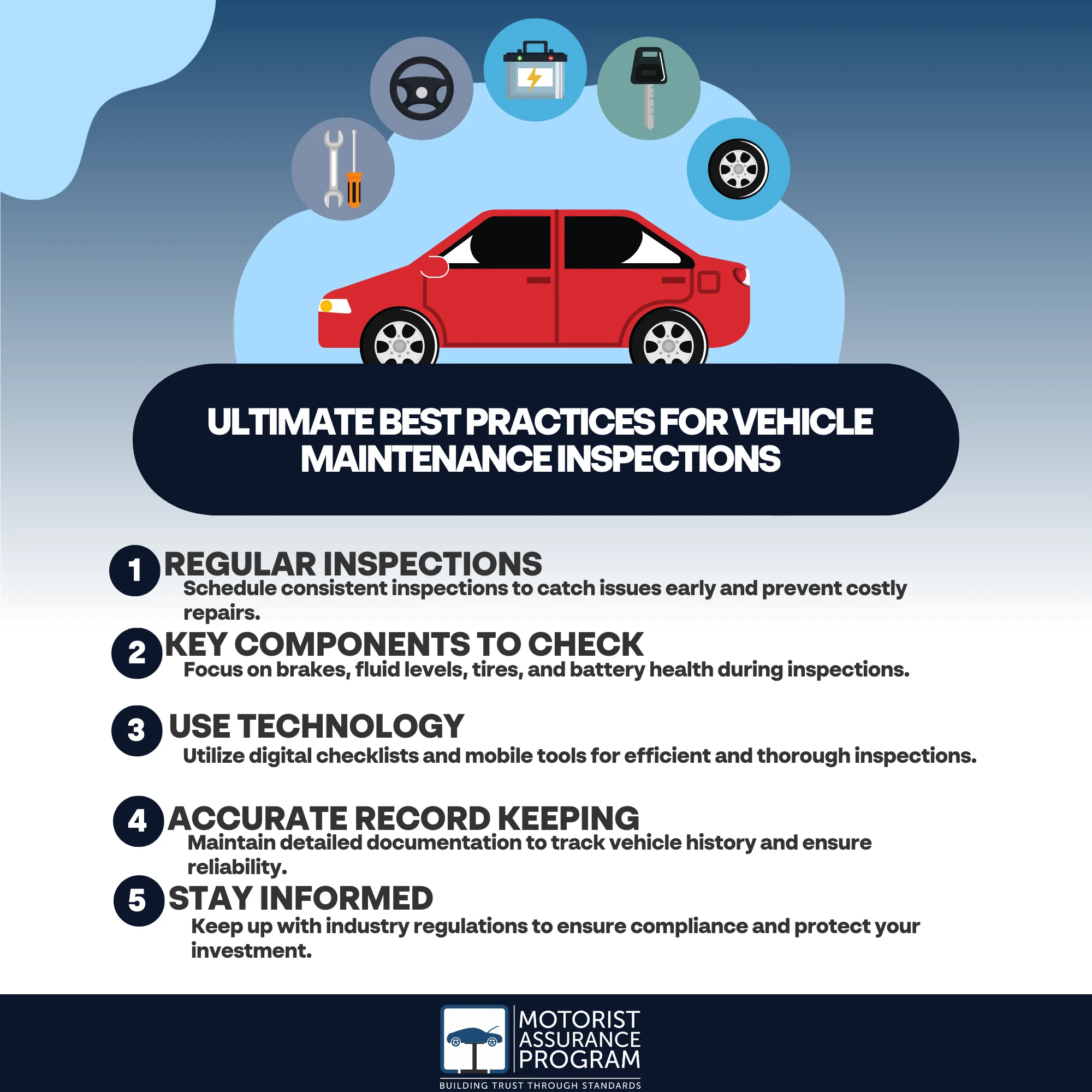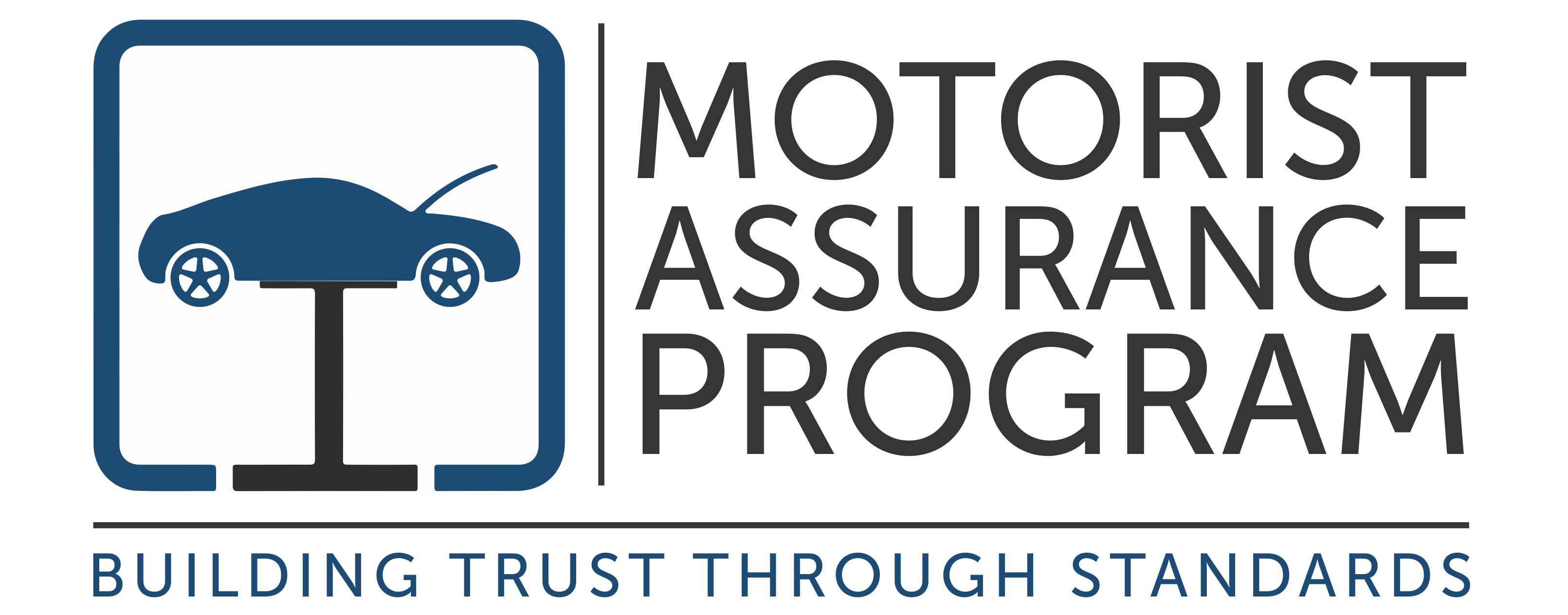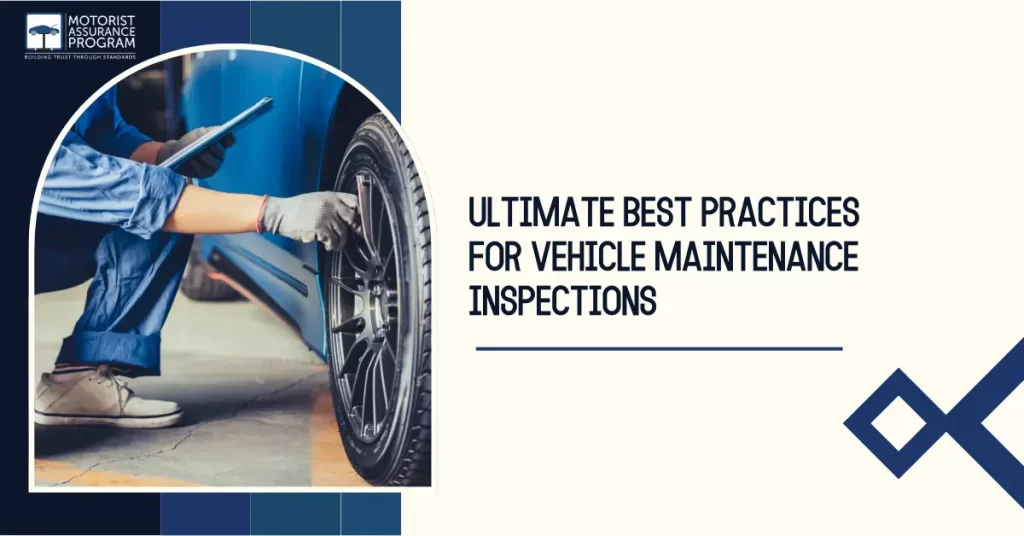Regular vehicle maintenance inspections are essential for your safety and your vehicle’s longevity. You should check key components like brakes, fluid levels, tire tread, and battery health. Scheduling consistent inspections helps you catch potential issues early, saving you from costly repairs down the road. Utilizing technology, like digital checklists and real-time data, can streamline these inspections, ensuring nothing is overlooked. Keeping detailed records of maintenance not only tracks vehicle history but also amplifies safety and reliability. Stay informed about inspection standards and regulations to remain compliant and protect your investment. You’ll discover even more ways to enhance your vehicle care next.

Key Takeaways
-
Regular inspections enhance vehicle safety, longevity, and fuel efficiency while preventing costly repairs.
-
Familiarize yourself with inspection standards to ensure compliance and recognize maintenance needs.
-
Key components like brakes, fluids, tires, and battery health should be routinely checked for optimal performance.
-
Utilize technology such as digital checklists and mobile tools to streamline inspections and record keeping.
-
Maintain detailed documentation of inspections and repairs to track vehicle history and identify potential issues.
Importance of Regular Inspections
Regular vehicle inspections are crucial for ensuring your safety on the road. By prioritizing these checks, you not only gain peace of mind but also enhance your vehicle’s longevity. An inspection checklist helps you identify potential issues before they escalate into costly repairs, leading to significant cost savings over time.
Maintaining your vehicle’s fuel economy is also vital, as it can reduce emissions and save you money on fuel. Resources on fuel economy information can guide you in understanding how regular maintenance impacts efficiency. Plus, regular maintenance contributes to safety assurance, allowing you to drive with confidence.
Repair forecasting becomes easier when you stay consistent with inspections. You’ll be more aware of your vehicle’s condition, enabling you to plan for necessary repairs before they turn into emergencies. This proactive approach creates driver awareness, ensuring you understand the importance of each component in your vehicle.
Regular inspections can positively impact the environment by reducing emissions and ensuring your vehicle runs efficiently. Staying updated with industry trends also keeps you informed about the latest technologies and practices, which can further improve your vehicle’s performance.
Embracing regular inspections isn’t just about compliance; it’s about taking charge of your driving experience, ensuring your car remains reliable and safe for you and your loved ones. So, don’t wait—make inspections a priority and enjoy the benefits they bring to your driving journey.
Understanding Inspection Standards
Understanding inspection standards is essential for any vehicle owner. These standards set the foundation for ensuring your vehicle remains safe and roadworthy. By familiarizing yourself with the inspection criteria, you empower yourself to recognize what needs attention during routine checks.
Compliance benchmarks serve as guidelines that help you gauge your vehicle’s performance against established safety and efficiency norms. Electric and hybrid vehicles, such as battery-electric vehicles (BEVs) and plug-in hybrid electric vehicles (PHEVs), have unique maintenance needs that also fall under these standards, particularly regarding their high-voltage systems and battery performance.
Staying informed about charging infrastructure and resources can enhance your understanding of your electric vehicle’s operational efficiency.
When you grasp these standards, you enhance your ability to make informed decisions about maintenance. You’ll know what to look for, from tire tread depth to brake functionality, and be better prepared when you visit a mechanic.
It’s not just about passing an inspection; it’s about creating a culture of responsibility and care for your vehicle.
So, take the time to learn these standards, and you’ll find that you’re not just a vehicle owner, but an informed advocate for your safety and well-being on the road.
Key Components to Inspect
When it comes to vehicle maintenance, knowing the key components to inspect can make all the difference in keeping your car safe and reliable.
Start with the brake pads; worn-out pads can greatly affect your stopping power. Next, check your fluid levels, including oil, coolant, and brake fluid, to guarantee your engine runs smoothly.
Don’t forget about tire tread—adequate tread depth is essential for traction and safety.
Battery health is another important area; clean connections and secure mounts can prolong vehicle life. Inspect your wiper blades for wear, as clear visibility is critical in adverse weather.
Your exhaust system should be free of leaks, which can impact performance and safety. Air filters also need attention; clean filters improve engine efficiency and air quality inside your vehicle.
Make sure your lighting systems, including headlights and taillights, are also functioning properly for nighttime visibility.
Finally, don’t overlook suspension components and alignment checks, as they contribute to a smooth ride and proper handling.
Scheduling Maintenance Effectively
Scheduling maintenance effectively is vital for keeping your vehicle in top shape.
Think about how often inspections are needed and identify the best times to schedule them, ensuring you’re not caught off guard by unexpected issues.
Frequency of Inspections
Your vehicle’s longevity hinges on a well-planned inspection schedule. By combining seasonal checks with mileage indicators, you can guarantee your vehicle remains in top condition. Regular inspections aren’t just a good idea; they’re pivotal to preventing unexpected breakdowns and costly repairs down the line.
Start by tracking your mileage. Many manufacturers recommend inspections every 5,000 to 7,500 miles, but this can vary based on your driving habits and vehicle type. If you frequently drive in harsh conditions, consider more frequent checks.
The key is consistency. Set reminders for inspections and don’t skip them. When you prioritize regular maintenance, you’re not just protecting your investment; you’re also guaranteeing your safety on the road.
Ideal Timing Strategies
To keep your vehicle running smoothly, timing plays a significant role in scheduling maintenance effectively.
Start by paying attention to seasonal considerations. For instance, before winter hits, verify your battery, antifreeze levels, and tires are in top shape. Cold weather can be hard on your vehicle, so a pre-winter check-up is essential.
Next, focus on mileage milestones. Most manufacturers recommend specific maintenance tasks at certain mileage intervals—like oil changes, brake inspections, and tire rotations. Keeping track of these milestones helps you stay ahead of potential issues, ultimately saving you money and stress.
Utilizing Technology in Inspections
Technology plays an essential role in upgrading vehicle maintenance inspections, streamlining processes, and improving accuracy. By utilizing mobile inspection tools, you can conduct inspections more efficiently than ever. These tools allow you to capture data on-the-go, making it easier to identify issues and document findings quickly.
Digital inspection checklists are another game-changer. They provide a structured framework for your inspections, ensuring that you don’t overlook critical components. With these checklists, you can easily mark items as inspected or needing attention, allowing for clear communication with your team.
Plus, digital records are often easier to store and retrieve than paper ones, helping you maintain accurate maintenance logs.
Embracing these technologies not only upgrades your inspection process but also promotes accountability. By keeping everything organized and accessible, you foster a culture of proactive vehicle maintenance.
Training for Inspection Personnel
Effective vehicle maintenance inspections rely not just on technology, but also on the expertise of the personnel conducting them. To guarantee thorough inspections, you need to prioritize training for your inspection team.
Start by focusing on personnel qualifications, as having well-trained staff is vital for effective assessments. Incorporate extensive training programs that cover essential inspection techniques, allowing your personnel to develop the skills necessary to identify potential issues accurately.
This training should include hands-on experience and classroom instruction, making sure your team understands the latest standards and best practices in vehicle maintenance.
Encourage your staff to pursue further certifications, which can enhance their knowledge and boost their confidence in performing inspections. Regular workshops can help keep them updated on new technologies and methodologies in the field.
Documentation and Record Keeping
Proper documentation and record keeping play an essential role in vehicle maintenance inspections. By keeping accurate records, you guarantee that your vehicle remains safe and reliable.
When you keep detailed maintenance logs and use inspection checklists, you can track the history of your vehicle’s maintenance and identify any recurring issues.
Here are some best practices for effective documentation:
-
Create Maintenance Logs: Regularly update maintenance logs to record each service performed, including dates, types of service, and any parts replaced.
-
Utilize Inspection Checklists: Use standardized inspection checklists for every inspection. This guarantees that you cover all essential components and reduces the chances of missing critical details.
-
Store Records Securely: Keep all documentation in a secure location, either digitally or physically, to protect it from loss or damage.
-
Review Regularly: Periodically review your records to evaluate trends or issues that may need attention. This proactive approach can help you stay
Frequently Asked Questions
How Often Should I Perform Vehicle Inspections for Optimal Performance?
You should perform vehicle inspections regularly for ideal performance. Incorporate routine inspection strategies and use an inspection checklist to cover essentials. This way, you’ll catch potential issues early and keep your vehicle running smoothly.
What Tools Are Necessary for Conducting a Thorough Vehicle Inspection?
For a thorough vehicle inspection, you’ll need an inspection checklist to guarantee you cover all areas. Diagnostic tools like OBD-II scanners help identify issues. Don’t forget basic supplies like a tire pressure gauge and flashlight.
Can I Perform Inspections Myself, or Should I Hire a Professional?
While self-inspection benefits include cost savings, hiring a professional inspection guarantees thoroughness and expertise, ultimately safeguarding your vehicle’s safety and longevity.
What Are Common Signs Indicating a Vehicle Needs Immediate Inspection?
You should watch for brake issues, fluid leaks, tire wear, engine noise, dashboard warnings, and steering problems. If you notice any of these signs, it’s time to get your vehicle inspected immediately.
How Do Weather Conditions Affect Vehicle Maintenance Inspections?
Think of your car as a delicate flower; seasonal considerations and temperature impacts can stress it. Cold weather might thicken fluids, while heat can cause tire pressure changes, so you need to inspect accordingly.
Conclusion
Regular vehicle inspections are crucial for safety and efficiency. By staying proactive with your inspections, you not only safeguard your well-being but also enhance your vehicle’s longevity and performance. Embrace the best practices outlined in this article, and you’ll be empowered to keep your vehicle in top shape.


